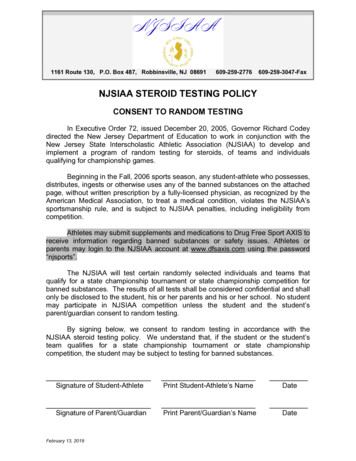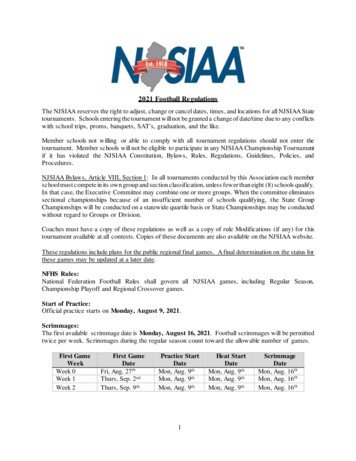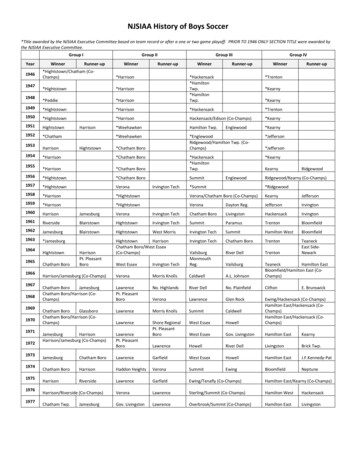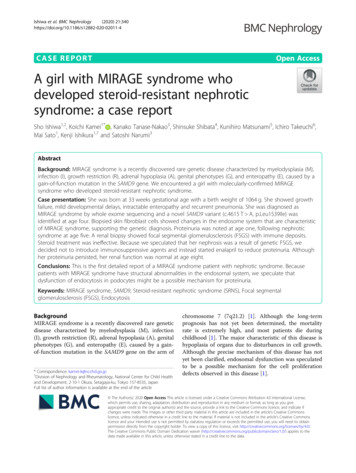
Transcription
1161 Route 130, P.O. Box 487, Robbinsville, NJ 08691609-259-2776609-259-3047-FaxNJSIAA STEROID TESTING POLICYCONSENT TO RANDOM TESTINGIn Executive Order 72, issued December 20, 2005, Governor Richard Codeydirected the New Jersey Department of Education to work in conjunction with theNew Jersey State Interscholastic Athletic Association (NJSIAA) to develop andimplement a program of random testing for steroids, of teams and individualsqualifying for championship games.Beginning in the Fall, 2006 sports season, any student-athlete who possesses,distributes, ingests or otherwise uses any of the banned substances on the attachedpage, without written prescription by a fully-licensed physician, as recognized by theAmerican Medical Association, to treat a medical condition, violates the NJSIAA’ssportsmanship rule, and is subject to NJSIAA penalties, including ineligibility fromcompetition.Athletes may submit supplements and medications to Drug Free Sport AXIS toreceive information regarding banned substances or safety issues. Athletes orparents may login to the NJSIAA account at www.dfsaxis.com using the password“njsports”.The NJSIAA will test certain randomly selected individuals and teams thatqualify for a state championship tournament or state championship competition forbanned substances. The results of all tests shall be considered confidential and shallonly be disclosed to the student, his or her parents and his or her school. No studentmay participate in NJSIAA competition unless the student and the student’sparent/guardian consent to random testing.By signing below, we consent to random testing in accordance with theNJSIAA steroid testing policy. We understand that, if the student or the student’steam qualifies for a state championship tournament or state championshipcompetition, the student may be subject to testing for banned substances.Signature of Student-AthletePrint Student-Athlete’s NameDateSignature of Parent/GuardianPrint Parent/Guardian’s NameDateFebruary 13, 2019
1161 Route 130, P.O. Box 487, Robbinsville, NJ 08691609-259-2776609-259-3047-FaxNJSIAA’S STEROID TESTING POLICYIn accordance with Executive Order 72, issued by the Governor of the State of New Jersey, RichardJ. Codey, on December 20, 2005, the NJSIAA will test a random selection of student athletes, whohave qualified, as individuals or as members of a team, for state championship competition.1. List of banned substances: A list of banned substances shall be prepared annually by theMedical Advisory Committee, and approved by the Executive Committee.2. Consent form: Before participating in interscholastic sports, the student-athlete and thestudent-athlete’s parent or guardian shall consent, in writing, to random testing inaccordance with this policy. Failure to sign the consent form renders the student-athleteineligible.3. Selection of athletes to be tested: Tested athletes will be selected randomly from all ofthose athletes participating in championship competition. Testing may occur at any statechampionship site or at the school whose athletes have qualified for championshipcompetition4. Administration of tests: Tests shall be administered by a certified laboratory, selected bythe Executive Director and approved by the Executive Committee.5. Testing methodology: The methodology for taking and handling samples shall be inaccordance with current legal standards.6. Sufficiency of results: No test shall be considered a positive result unless the approvedlaboratory reports a positive result, and the NJSIAA’s medical review officer confirmsthat there was no medical reason for the positive result. A “B” sample shall be availablein the event of an appeal.7. Appeal process: If the certified laboratory reports that a student-athlete’s sample hastested positive, and the medical review officer confirms that there is no medical reasonfor a positive result, a penalty shall be imposed unless the student-athlete proves, by apreponderance of the evidence, that he or she bears no fault or negligence for theviolation. Appeals shall be heard by a NJSIAA committee consisting of two members ofthe Executive Committee, the Executive Director/designee, a trainer and a physician.Appeal of a decision of the Committee shall be to the Commissioner of Education, forpublic school athletes, and to the superior court, for non-public athletes. Hearings shallbe held in accordance with NJSIAA By-Laws, Article XIII, “Hearing Procedure.”
8. Penalties. Any person who tests positively in an NJSIAA administered test, or anyperson who refuses to provide a testing sample, or any person who reports his or her ownviolation, shall immediately forfeit his or her eligibility to participate in NJSIAAcompetition for a period of one year from the date of the test. Any such person shall alsoforfeit any individual honor earned while in violation. No person who tests positive,refuses to provide a test sample, or who reports his or her own violation shall resumeeligibility until he or she has undergone counseling and produced a negative test result.9. Confidentiality: Results of all tests shall be considered confidential and shall only bedisclosed to the individual, his or her parents and his or her school.10. Compilation of results: The Executive Committee shall annually compile and report theresults of the testing program.11. Yearly renewal of the steroid policy: The Executive Committee shall annually determinewhether this policy shall be renewed or discontinued.June 1, 2007-2-
2021-22 NJSIAA Banned SubstancesIt is the student-athlete’s responsibility to check with the appropriate or designated athletics staff before using any substance.The NJSIAA bans the following drug classes.1.2.3.4.5.6.7.8.9.StimulantsAnabolic agentsAlcohol and beta blockersDiuretics and other masking agentsNarcoticsCannabinoidsPeptide hormones, growth factors, related substances and mimeticsHormone and metabolic modulatorsBeta-2 agonistsNote: Any substance chemically/pharmacologically related to all classes listed above and with no current approval by anygovernmental regulatory health authority for human therapeutic use (e.g., drugs under pre-clinical or clinical development ordiscontinued, designer drugs, substances approved only for veterinary use) is also banned. The institution and the student-athleteshall be held accountable for all drugs within the banned-drug class regardless of whether they have been specifically identified.There is no complete list of banned substances.Substances and Methods Subject to Restrictions: Blood and gene doping.Local anesthetics (permitted under some conditions).Manipulation of urine samples.Beta-2 agonists (permitted only by inhalation with prescription).Tampering of urine samples.NJSIAA Nutritional/Dietary Supplements:Before consuming any nutritional/dietary supplement product, review the product and its label with your athletics department staff.Many nutritional/dietary supplements are contaminated with banned substances not listed on the label. Nutritional/dietary supplements, including vitamins and minerals, are not well regulated and may cause a positive drug test.Student-athletes have tested positive and lost their eligibility using nutritional/dietary supplements.Any product containing a nutritional/dietary supplement ingredient is taken at your own risk.Athletics department staff should provide guidance to student-athletes about supplement use, including a directive to have any productchecked by qualified staff members before consuming. The NJSIAA subscribes only to Drug Free Sport AXISTM for authoritativereview of label ingredients in medications and nutritional/dietary supplements. Contact the Drug Free Sport AXIS at 816-474-7321 ordfsaxis.com (password: njsports).
THERE IS NO COMPLETE LIST OF BANNED SUBSTANCES. DO NOT RELY ON THIS LIST TO RULE OUT ANY LABEL INGREDIENT.Drug ClassesStimulantsSome Examples of Substances in Each ClassAmphetamine (Adderall)Caffeine (Guarana)CocaineDimethylbutylamine (DMBA; AMP)Dimethylhexylamine (DMHA; ineMethylhexanamine (DMAA; Forthane)Methylphenidate (Ritalin)Mephedrone (bath salts)ModafinilOctopaminePhenethylamines (PEAs)PhentermineSynephrine (bitter orange)Exceptions: Phenylephrine and Pseudoephedrine are not banned.Anabolic AgentsAndrostenedioneBoldenoneClenbuterolDHCMT (Oral Turinabol)DHEA eOxandroloneSARMS [Ligandrol (LGD-4033); Ostarine; RAD140; ohol and Beta opranololTimololDiuretics and Masking othiazideProbenecidSpironolactone : Finasteride is not hine (heroin)Fentanyl, and its inoidsMarijuanaSynthetic cannabinoids (Spice; K2; JWH-018; JWH-073)Tetrahydrocannabinol (THC)Peptide Hormones, growth factors,related substances and mimeticsGrowth hormone (hGH)Human Chorionic Gonadotropin (hCG)Erythropoietin zocinePethidineIGF-1 (colostrum; deer antler velvet)Ibutamoren (MK-677)Exceptions: Insulin, Synthroid and Forteo are not banned.Hormone and Metabolic ModulatorsAromatase Inhibitors [Anastrozole (Arimidex); ATD (androstatrienedione); Formestane; Letrozole]Clomiphene (Clomid)FulvestrantGW1516 (Cardarine; Endurobol)SERMS [Raloxifene (Evista); Tamoxifen (Nolvadex)]Beta-2 eSalbutamolSalmeterolAny substance that is chemically related to one of the above classes, even if it is not listed as an example, is also banned.It is your responsibility to check with the appropriate or designated athletics staff before using any substance. Many nutritional/dietarysupplements are contaminated with banned substances not listed on the label.Information about ingredients in medications and nutritional/dietary supplements can be obtained by contacting Drug Free Sport AXIS at816-474-7321 or dfsaxis.com (password: njsports).
New Jersey State Interscholastic Athletic Assoc.Route 130Robbinsville NJ 08691Phone: 609-259-2776Fax: 609-259-3047NJSIAA Anabolic Steroid-Testing Protocols 2021-2022Organization1. The New Jersey State Interscholastic Athletic Association (NJSIAA) Executive Committeehas selected Drug Free Sport International (Drug Free Sport), Kansas City, MO, to be theofficial administrator of the NJSIAA Anabolic Steroid Testing Policy.2. The New Jersey State Interscholastic Athletic Association (NJSIAA) Executive Committeehas selected the UCLA Olympic Analytical Laboratory, Los Angeles, CA, to be the officialaccredited laboratory of the NJSIAA Anabolic Steroid Testing Policy. The administratormay utilize another laboratory if required, so long as the laboratory is accredited by theWorld Anti-Doping Agency.Championship and Athlete Selection1. Selection of specific championship teams and events for anabolic steroid testing will berecommended by Drug Free Sport and will be approved by the NJSIAA.2. Selection of sports for anabolic steroid testing will occur prior to the commencement of thechampionship seasons for those sports.3. All athletes competing in state championship competition are subject to testing.4. Athletes may be tested before, during or after any phase of state championship competition.Drug Free Sport International4/15/21
Championship and Athlete Notification1. Upon notification that their institution has been selected for drug testing, Schoolsparticipating in NJSIAA championship competition will be required to provide an accurateand current roster of the athletes on the varsity team that has qualified for the championshipcompetition to the email provided that is mentioned in the notification as soon as possible.2. Athletes selected for anabolic steroid testing will be notified of their selection by aninstitutional designee or Drug Free Sport. The athlete’s coach or an administrator from theathlete’s school will be notified also.3. The athlete will be instructed to read and sign an anabolic steroid-testing notification form.The form will instruct the athlete to report to a collection station at the appointed time withan official representative of the school (e.g., administrator, coach, athletic trainer).4. The athlete may select a witness (e.g., parent or guardian) to accompany the athlete to thecollection station. Any witness must remain in the collection station through the entirecollection process.Specimen Collection Procedures1. Only those persons authorized by the collection crew chief or school representative/sitecoordinator will be allowed in the collection station.2. Upon entering the collection station, the athlete will provide photo identification and/or aschool representative/site coordinator will identify the athlete and the athlete will officiallybe signed into the collection station.3. The crew chief and/or school representative may release a sick or injured athlete from thecollection station or may release an athlete to return to competition or meet academicobligations only after appropriate arrangements for having the athlete tested have been madeand documented.4. With the collector’s and/or school representative/site coordinator’s assistance, a member ofthe drug testing crew will review the athlete’s information, including name, grade,sport/activity, position, and gender in SCAN . The athlete will select a set of beakerbarcodes that will be assigned to them for the testing process. Once completed, the crewmember will instruct the athlete to wait in a specific area of the collection room for themonitor-collector.5. A collector, serving as monitor (must be same gender as athlete), will determine the athlete’sreadiness to provide a specimen and then instruct the athlete to select a beaker from a supplyof such. [Note: the beakers MUST be adequately secured in the collector room and closelyobserved by the collectors at ALL TIMES. The beakers must NOT be placed near the exit.]6. The monitor will take the collection form from the athlete and then escort the athlete to therestroom having the athlete keep the beaker in the monitor’s view at all times.Page 2 of 7
7. Athletes may not carry any item other than his/her beaker into the restroom when providing aspecimen. The athlete must remove all outer clothing (e.g., jackets, sweaters). Any problemor concern should be brought to the attention of the collection crew chief or schoolrepresentation for documentation.8. A collector will serve as a monitor to assure the integrity of the specimen until the designatedvolume of urine has been collected. The monitor must secure the room being used for themonitored collection so that no one except the athlete and the monitor can enter it until afterthe collection has been completed. Dying agents will be added to toilet bowls to preventsample substitution and any unsupervised access to water will be eliminated during thecollection process.9. Monitors must be members of the official drug-testing crew and of the same gender as theathlete providing the specimen. The athlete is required to empty contents of all pockets(pockets should be turned inside out) and place in container to be left in a location where theathlete and the monitor can observe. The monitor must request the athlete raise his/her shirthigh enough to observe the midsection area completely ruling out any attempt to manipulateor substitute a sample.10. The monitor will instruct the athlete to rinse and dry hands (no soap).11. The monitor will then hand the athlete the second half of the beaker barcode strip that theathlete picked out and have the athlete place the barcode directly on top of his/her beaker.This should be done PRIOR to urinating into the beaker.12. The monitor will allow the athlete to enter the stall and close the door for privacy during thevoiding process. If the monitor hears sounds or makes other observations indicating andattempt to tamper with a specimen, there must be an additional collection.13. The athlete must provide specimen volume of at least 90 mL.14. Once a specimen is provided, the athlete is responsible for keeping the collection beakerclosed and controlled. Athletes are then encouraged to wash hands with soap and waterfollowing urination. The monitor will inspect the volume and temperature of urine in thebeaker and if not an adequate volume, place a line with a marker at the urine volume level onthe outside of the beaker. The athlete should be instructed to secure the beaker. The monitormust NOT touch the beaker.15. The athlete is allowed to place belongings back into his/her pockets.16. The monitor must then escort the athlete back to the collection room keeping the athlete andhis/her beaker in full view the entire time. The monitor will provide the athlete with his/hercollection form and must instruct the athlete where to sit, how to maintain integrity of thespecimen and their collection form. The monitor should also advise on fluids and/or food.17. Fluids and food given to athletes who have difficulty voiding must be from sealed containers(approved by the collector) that are opened and consumed in the station. These items must befree of any other banned substances.Page 3 of 7
18. If the specimen is incomplete, the athlete must remain in the collection station until thesample is completed. During this period, the athlete is responsible for keeping the collectionbeaker closed and controlled.19. If the athlete has to leave, any incomplete specimen will be discarded. The crew chief willdocument the reason for the athlete’s departure as well as the time at which the athlete willreturn in SCAN .20. Upon return to the collection station, the athlete will begin the collection procedure again.21. Once an adequate volume specimen is provided, the monitor may initial in the spaceprovided on the collection form and also mark the appropriate temperature box. The monitorwill escort the athlete to the specimen processing table.22. A collector serving as specimen processor will verify (with the athlete verbally) the beakerbarcode ID numbers match between the top of the beaker and the collection form and assurethe athlete’s name on the collection form is correct. The specimen collector will instruct theathlete to closely observe the specimen processing steps.23. The specimen processor will then pour less than 5 mL of urine from the beaker into a smallcup and measure the specific gravity using a refractometer.24. If the urine has a specific gravity below 1.005 (1.010 if measured with a reagent strip), thevalue will be recorded on the collection form, and the specimen will be discarded by theathlete with the monitor observing. The athlete must remain in the collection station untilanother specimen is provided. The athlete will pick out another beaker barcode strip with aset of the same barcode number and will provide another specimen.25. If the urine is concentrated (1.005 SG or higher), the specimen processor will record thespecific gravity value on the collection form.26. Once the specimen processor has determined the specimen has a specific gravity above1.005, the sample will be processed and sent to the laboratory. The laboratory ultimatelymakes final determination of sample adequacy.27. If the laboratory determines that an athlete’s sample is inadequate for analysis, at the school’sdiscretion, another sample may be collected.28. If an athlete is suspected of manipulating specimens (e.g., via dilution), the school will havethe authority to perform additional tests on the athlete.29. Once a specimen has been provided that meets the on-site specific gravity, the athlete willselect a sample collection kit from a supply of such.30. The specimen processor will open the kit, demonstrate to the athlete the vials are securelysealed, open the plastic, and open the A vial lid. The processor will pour approximately 60mL of urine into the “A vial” and close the lid. The processor will pour approximately 25 mLinto the “B vial” and close the lid.Page 4 of 7
31. The specimen processor will securely close the lids on each vial and then seal each vial usingthe vial seals from a set of specimen seals that the student-athlete will pick out and verify thatall seal numbers are the same. The processor will assure that all seals are tightly adhered tothe vials with no tears or loose areas. The samples will then be placed into a sample bagwhich will then be placed into the specimen kit box. The box will then be sealed using thebox seal on the set of specimen seals that the athlete has chosen out. Once this is complete,the specimen processor will take the kit from the student athlete, ask them to verify that theseal number on the box is the same as the seal number that was placed on the notificationform, and send them to the crew member in charge of check out.32. A crew member must then collect all necessary signatures (and dates/times where indicated)in SCAN (donor, monitor, and collector). Any deviation from the procedures must bedescribed and recorded. If deviations are alleged, the athlete will be required to provideanother specimen.33. The athlete is then released by the collector.34. All sealed samples will be secured in a shipping case. The collector will prepare the case forforwarding.35. After the collection has been completed, the samples will be forwarded to the laboratory andcopies of any forms forwarded to the designated persons.36. The samples become the property of the school.37. If the athlete does not comply with the collection process, the collector will notify the schoolrepresentative/site coordinator and third party administrator responsible for management ofthe drug-testing program.38. All specimens become the property of the NJSIAA.Page 5 of 7
Chain of Custody1. The crew chief or his/her designate will deliver the shipping case to the carrier.2. Upon receipt at the laboratory, a laboratory employee will record that the shipping case hasbeen received by the carrier.3. The laboratory will record whether the numbered seal on each specimen arrived intact.4. If the specimen arrives at the laboratory with security seals not intact, the NJSIAA maycollect another specimen from the athlete.Notification of Results1. The laboratory will use a portion of Specimen A for its initial analysis2. The designated laboratory certifying scientist will review all results showing a bannedsubstance and/or metabolite in Specimen A.3. The laboratory will inform Drug Free Sport of the results by each respective code number.4. Drug Free Sport will notify the school of the results of any negative test.5. When Specimen A is positive, Drug Free Sport will contact the NJSIAA medical reviewofficer as soon as possible. The MRO will provide final review of Specimen A results.6. The MRO will contact the parent of the student-athlete with a positive finding on SpecimenA to discuss the result and determine if a medical exception shall be granted to the studentathlete. The MRO will make a decision regarding whether to grant a medical exceptionwithin nine (9) business days of receiving the result from Drug Free Sport, unless good causeis shown for extending that time. The MRO will forward the decision to Drug Free Sportwhich will contact the school, the parent or guardian and the NJSIAA regarding the MRO’sdecision.7. Drug Free Sport will further notify the parent or guardian that he or she may request thatSpecimen B be tested, and may request to be present or represented at the opening ofSpecimen B, and that he or she must inform Drug Free Sport within 72 hours if he or sherequests to have Specimen B tested.8. In the event that the athlete does not request that Specimen B be tested, Specimen A findingswill be final.9. In the event that the athlete requests the testing of Specimen B, the results of Specimen Bwill be final.10. Results of all tests shall be considered confidential and shall only be disclosed by theNJSIAA to the athlete, his/her parents or guardian, his/ her school, and the medical reviewofficer.Page 6 of 7
11. The NJSIAA Steroid Testing Policy treats an athlete who fails to provide a testing sample thesame as an athlete who tests positive. For that reason, any athlete who refuses to sign thenotification form, fails to arrive at the collection station at the designated time withoutjustification, fails or refuses to provide a urine specimen according to protocol, leaves thecollection station before providing a specimen according to protocol or attempts to alter theintegrity or validity of the urine specimen and/or collection process will be treated as if therewas a positive for a banned substance.Appeal1. If the athlete desires to appeal the results of a positive anabolic steroid test, a written requestfor an appeal must be received by the NJSIAA no later than 20 days after the athlete receivesnotification of the positive result from the NJSIAA.2. Appeals shall be conducted according to the provisions of NJSIAA’s Anabolic SteroidTesting Policy as approved by the NJSIAA Executive Committee.3. An athlete who tests positive will not be eligible to participate in sports pending his/herappeal.Protocol TermsCollection Station:A controlled room or area with access to restrooms for purposes of urinespecimen collection for sports anabolic steroid testing.Collector:Member of the collection crew.Collection Crew:The crew chief, collectors and monitors.Crew Chief:A certified specimen collector who manages the collection station, thecollectors and monitors under the direction of The National Center forDrug Free Sport, Inc.Monitor:Member of the collection crew who is the same gender as the athlete beingtested.WADA:World Anti-Doping Agency, the certification body for laboratories testingfor anabolic steroids and other drugs banned in sport.Page 7 of 7
NJSIAA STEROID TESTING POLICYFREQUENTLY ASKED QUESTIONSOn June 7, 2006, New Jersey became the first state in the nation to require steroid testingfor high school athletes. The testing policy was developed by the New Jersey StateInterscholastic Athletic Association (NJSIAA), a private, nonprofit association of public,parochial and private high schools that organizes high school sports in New Jersey.These frequently asked questions address common questions and concerns about thepolicy.1. How did the NJSIAA’s steroid testing policy come about?In 2005, then-Governor Richard Cody convened a Governor’s Task Force onSteroid Use and Prevention. The task force was chaired by Monsignor Michael E.Kelly, Headmaster of Seton Hall Preparatory School, and included physicians,attorneys, school administrators, coaches and athletic trainers. The task forcereported the following: “According to the National Institute on Drug Abuse,3.4% of high school seniors have used anabolic steroids at least once, and 1.9% ofeighth graders admitted to trying steroids. Numerous studies have shown the useof steroids and steroid precursors to be on the upswing. Unfortunately, thecompulsions to achieve a desirable body image, to succeed in athletics, or toobtain a college scholarship are strong motivators and influences. Theseinfluences cause some young people to risk their long-term health by usingperformance-enhancing substances as a short cut to meeting their goals.” (TaskForce Report, page 26.) Based on the task force’s recommendations, onDecember 20, 2005, Governor Cody signed Executive Order 72, which directedthe New Jersey Department of Education to work in conjunction with the NJSIAAto develop and implement a program of random testing for steroids.2. Why test for steroids?First, using steroids without a prescription can cause serious, adverse healtheffects. Second, using steroids and other performance-enhancing drugs can giveathletes an unfair advantage over their competition, and is cheating. Third,testing for steroids can help deter their use among high school students. Finally,steroids are drugs that should be used to treat medical conditions. Possession oruse of most steroids without a prescription is illegal. The NJSIAA recognizes thatit will take a community-wide effort by parents, coaches, athletes, teachers andphysicians to attack this growing challenge. Random steroid testing is one toolthat can be used to help discourage athletes from taking steroids.
3. What are some of the specific health problems associated with steroid abuse?The Governor’s Task Force found that steroid abuse can result in a host of serioushealth problems. The following is a partial list of health problems associated withsteroid abuse: severe acne, excessive hairiness in both sexes, male patternbaldness, deepening of the voice, abnormal permanent enlargement of the clitoris,loss of female body contour, altered menstrual cycling, increased libido inwomen, testicular atrophy, elevated blood pressure and other adverse cardiovascular effects, thickening of the blood, liver disease, increased aggressiveness,obstructive sleep apnea, enlarged breasts in men and women, impotence, bloodclots, diabetes, elevated fats in the blood, premature closure of the growth platesresulting in reduction of height, migraine headaches, premature puberty andinfertility.4. How did the NJSIAA develop its steroid testing policy?In early 2006, the NJSIAA staff worked with a specially-appointed “SteroidCommittee” and with its Medical Advisory Committee to develop a list of bannedsubstances and a policy for testing student athletes. The policy was formallyadopted by the NJSIAA Executive Committee on June 7, 2006.5. What does the steroid testing policy say?The NJSIAA steroid testing policy states, “It shall be considered a violation of theNJSIAA sportsmanship rule for any student athlete to possess, ingest or otherwiseuse any substance on the list of
has selected the UCLA Olympic Analytical Laboratory, Los Angeles, CA, to be the official accredited laboratory of the NJSIAA Anabolic Steroid Testing Policy. The administrator may utilize another laboratory if required, so long as the laboratory is accredited by the World Anti-Doping Agency. Championship and Athlete Selection 1.










